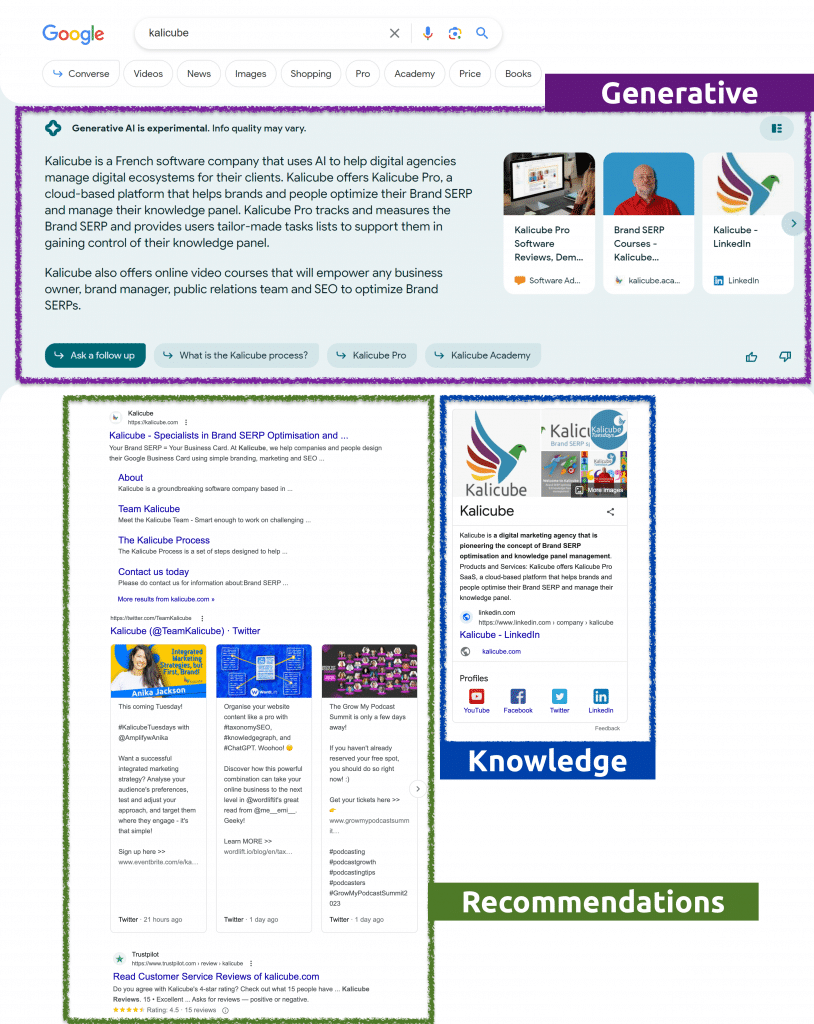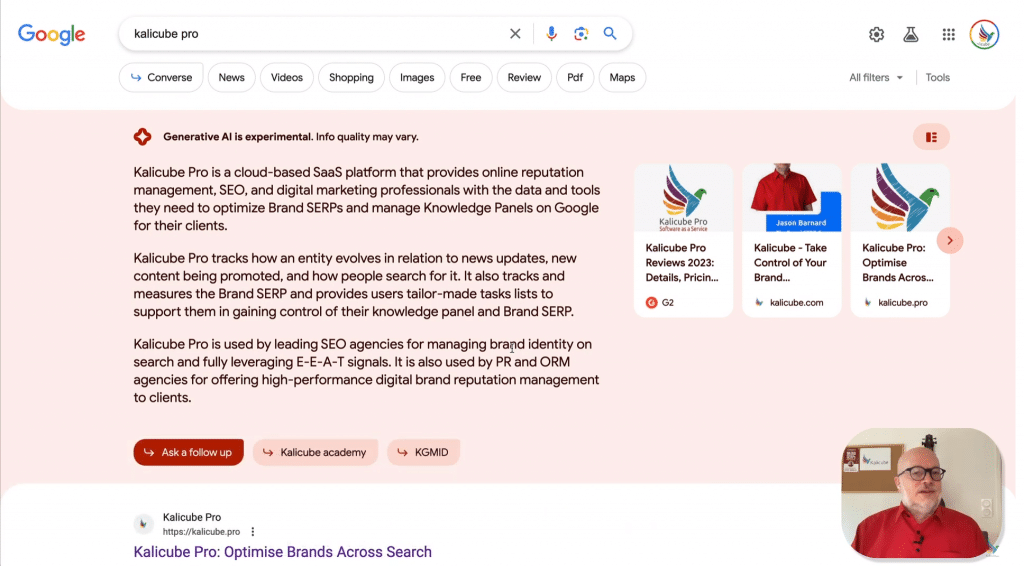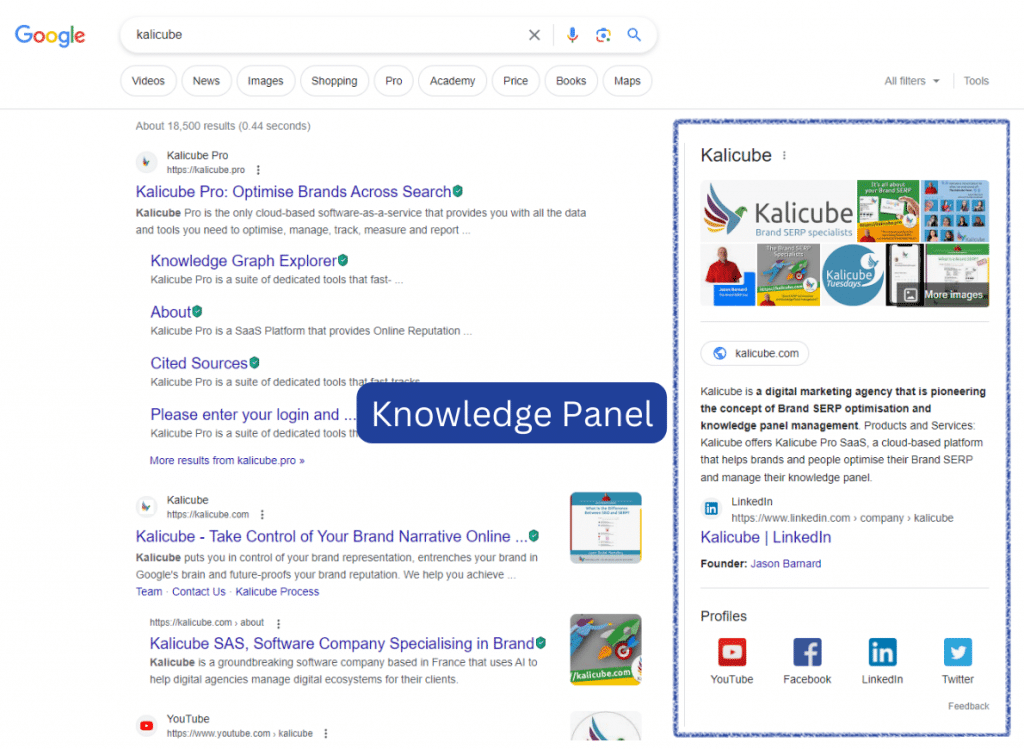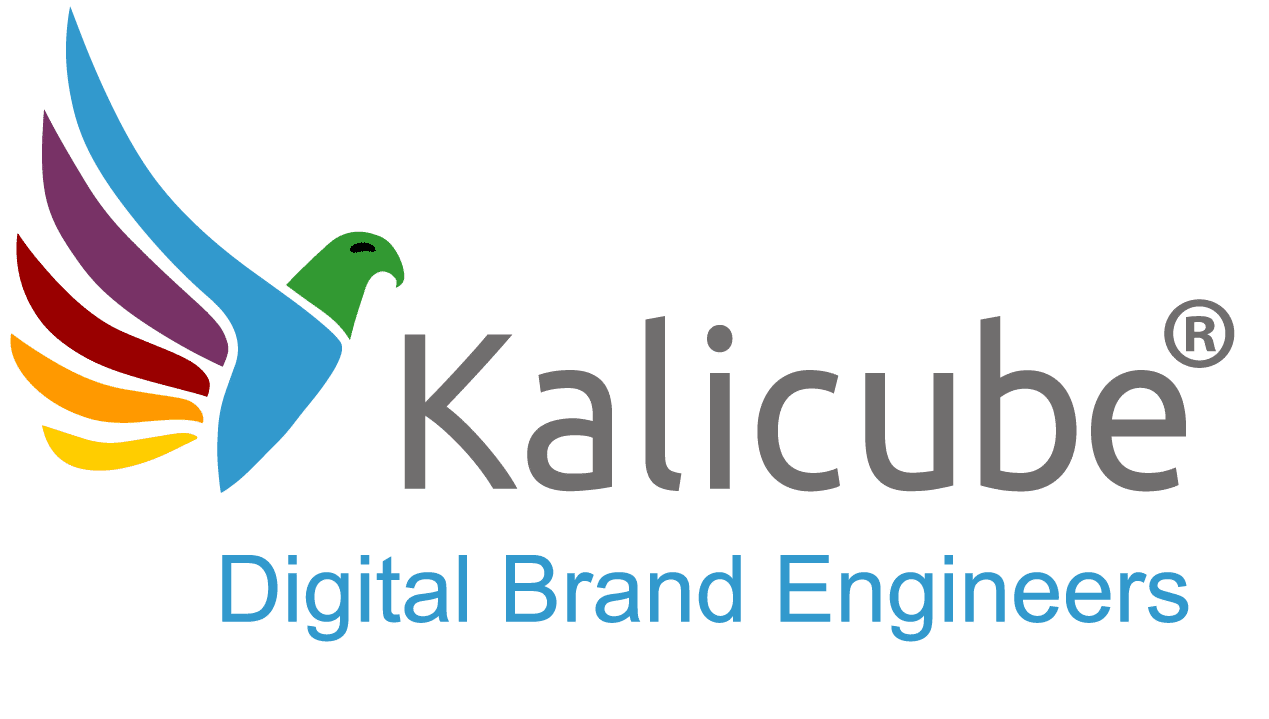What is Google’s Search Generative Experience (Now Called AI Overviews)

Google’s Search Generative Experience (SGE) is a dynamic Knowledge Panel about a topic or Named Entity, such as a company or a person. SGE creates a dynamic Knowledge Panel using the contents of the web pages behind the search results AND the information in the Knowledge Graph.
How does Google Create the Search Generative Experience?
Google’s Generative AI uses Artificial Intelligence (AI) models to produce answers to a specific search query.
In search, Google can use Generative AI to create a written (factual) answer to a search query using information from its multiple Knowledge Graphs and information from webpages in its web index. The result is at the top of the search results page.

Additionally, SGE provides helpful links with cards and additional suggested follow-up questions.
We can consider the SGE result on Google to be a summary of the information that Google confidently understands about a topic or Named Entity to provide the relevant information to the user, thus saving the user time and effort of clicking through to multiple results to gather the information themselves. This is very similar to the role and functionality of a Knowledge Panel (Google states a Knowledge Panel “are meant to help you get a quick snapshot of information on a topic based on Google’s understanding of available content on the web.”

Thus, at Kalicube, we approach Google’s Search Generative Experience results as “dynamic Knowledge Panels”.
Does Search Generative Experience Help Brand SERPs?
SGE is a combination of Brand SERPs and information in the Knowledge Graph. It’s a delightful opportunity for Brands who want to control their Brand message across the digital landscape.
At Kalicube, we analyse the SERP in three parts: Knowledge, Recommendations and Generative AI. The Generative AI result for your Brand: company, person, product or thing is a combination of Google’s Knowledge and its Recommendations.

Pro Tip: Managing the SGE results for your Brand is baked into The Kalicube Process™.

In his presentation, Jason Barnard explains Google’s Search Generative Experience and how you can take more control of your Brand message.
Google can automatically generate answers with descriptions, follow-up questions, and Knowledge Panel Cards if it has sufficient understanding and confidence in the information. It can do this using a combination of a traditional Knowledge Panel or the Brand SERPs for your Brand.
For example, Google can create dynamic Knowledge Panels for Jason’s company, Kalicube, and for Entities like ‘Kalicube Pro’ because it has enough information to make educated guesses about those Entities.
Google’s ability to automatically generate answers with descriptions, follow-up questions, and Knowledge Panel Cards depends on how much Google understands and trusts the available information.
When Google has enough data and confidence about an Entity, such as Kalicube or “Kalicube Pro,” SGE can create dynamic Knowledge Panels that contain helpful and “on-brand” details. These panels show Google’s educated guesses and insights about these Entities, providing users with a comprehensive view of the information available.

The good news is, Brands can influence and control how the machines understand and present your Brand.
Pro Tip: Brands can create their SGE dynamic Knowledge Panel if they educate the search engines clearly and consistently about who they are, what they do and who they serve. When Brands aren’t educating the machines, the machines apply their knowledge about your Brand and display it in the SGE result.
At Kalicube, we accomplish this through the Kalicube® Process. The Kalicube Process easy-to-implement process that empowers brands to educate the machines and control the way their Brand shows up across the digital landscape.
Does Generative AI show a result if a Brand has a traditional Knowledge Panel?
If a Brand has a Knowledge Panel in Google’s Knowledge Graph, SGE chooses not to display a SGE result because “Kalicube” has a rich Knowledge Panel on the right-rail. It shows the Knowledge Panel instead of the dynamic Knowledge Panel because it is confident in the information about the brand.
If the Knowledge Panel lacks information or Google isn’t confident about its understanding of the Brand, Google has two options. It may show the Knowledge Panel AND allow users to generate an answer.
Google showing the Knowledge Panel of Kalicube.


Google allowing users to generate an answer.
If a Brand’s Knowledge Panel isn’t rich enough or Google isn’t confident in its understanding of the Brand, it may show the Knowledge Panel in the right-rail AND give users the option to generate an answer too.
In this example, the search query “Olga Zarr” on the right shows a Knowledge Panel without the Knowledge Panel Cards. Google gives you the option to generate an answer, and it will produce the results by creating a dynamic Knowledge Panel based on its guesses about what it finds on the left-hand side.

If the search query is “Olga Zarzeczna,” her original name, Google has enough information to generate a dynamic Knowledge Panel but doesn’t display the Knowledge Panel on the right-rail. Even though she is known as Olga Zarr in the Knowledge Graph, Google is making an educated guess and not relying solely on the existing Knowledge Graph data.

Looking at Entities like ‘Kalicube Tuesdays,’ Google doesn’t generate a dynamic Knowledge Panel or ask follow-up questions because it doesn’t have confidence in the available information. It’s a cautious approach ensuring Google maintains data accuracy and user experience.

Why doesn’t Generative AI always allow users to Generate Answers?
Generative AI doesn’t produce answers for Entities when it has sufficient information in Google’s Knowledge Graph. Google is confident it understands the Entity and doesn’t need to guess.
When Google displays an extensive Knowledge Panel, such as the one for ‘Joost de Valk,’ it means that the search engine has gathered a wealth of information from its Knowledge Graph. In these cases, Google does not usually allow users to generate their answers, as it already has extensive knowledge about the Entity. The purpose of the Knowledge Panel is to provide users with a well-rounded and detailed overview of the entity, leaving little room for user-generated answers.

When Google’s Knowledge Graph contains extensive data about a particular Entity, it can generate a detailed Knowledge Panel encompassing various aspects, including biographical information, achievements, notable works, and other relevant details. Through the Knowledge Graph, Google aims to give users a comprehensive overview of the Entity without needing user-generated content or additional contributions.
In conclusion, Jason notes that these Search Generative Experiences reflect Google’s functionality in creating recommendations and the varying levels of confidence in its information to generate Knowledge Panels.
Guidelines for Search Generative Experience (Dynamic Knowledge Panel) on Google Brand SERPs:
- If the Brand SERP has a Knowledge Panel without Knowledge Panel Cards, Google displays the Knowledge Panel. It also allows users to generate an SGE result.
- If the Brand SERP has a Knowledge Panel with Knowledge Panel Cards, Google doesn’t allow the searcher to generate an SGE result. If the user clicks “Converse”, it simply displays the Brand SERP with the full Knowledge Panel.
- If the Brand SERP does not have a Knowledge Panel, but Google is very confident that it can generate a helpful and factually correct SGE, it will. Also known as a dynamic Knowledge Panel, Google will use information from the left-rail of the Brand SERP and display the SGE when the page loads.
- If the Brand SERP doesn’t have a Knowledge Panel, but Google has confidence it can generate a helpful and factually correct SGE, it allows users to generate an SGE result.
- If the Brand SERP does not have a Knowledge Panel and Google is not confident it can generate a helpful and factually correct SGE, it won’t allow users to generate an SGE result.
Where does my Brand fit in Search Generative Experience?

These different scenarios are an excellent KPI to measure Google’s understanding and confidence in its understanding of an Entity (company, person, product, etc.).
#5 shows the lowest understanding and least confidence, and #1 is the most understanding and confident. In the new era of Entities in search, this KPI allows us at Kalicube to examine the Brand’s position. We can evaluate the work required to bring a Brand or person to the ideal level where Google is fully confident in its understanding.
From a user experience perspective, when your audience Googles your company or personal name, every Brand should aim to rank #1 or #2, if only to get Google’s “stamp of approval.”
Why is this so important? Because Google users use Google because they trust Google. If Google provides you or your company with a positive, accurate and compelling Knowledge Panel and Search Generative Experience, that person is more likely to trust YOU.
Read more about Google’s Generative AI in Search here >>
Kalicube can Entrench You or Your brand in ChatGPT, Bard and Google’s Generative AI in Search
The Kalicube® Process and Kalicube Pro™ “educate” Google, Bing, Apple, Amazon and other companies that use Knowledge Algorithms.
Using the Kalicube Process, any company or person can have a Knowledge Panel, which means they will have a place in the Knowledge Graphs used by Google and Bing. This is a massive advantage for “ranking” in their AI-driven chatbots.
Kalicube helps Google and Bing understand the facts about your cornerstone Entity: the company, its featured products, and its people. Once Google and Bing understand and are confident about the facts surrounding your Entity, feeding the algorithms with additional related information is significantly easier.
This means your Brand earns a place in the Knowledge Graph and is a trusted fact the engines can serve confidently - both in a Knowledge Panel and in the Bard and Bing Chat results. Our approach is a future-proof approach to your digital presence across search.
For the last 10 years at Kalicube, we have perfected the strategies you can use to educate Knowledge Algorithms about the facts about Entities.
We do this through the methods listed below.
- Clear explanations that are easy for the Knowledge Algorithms to consume, process and digest;
- Proactively correcting corroborative information to ensure consistency of information across the web;
- Carefully building sources the algorithms trust BUT are owned and controlled by our clients (publishers and authors - think E-E-A-T on steroids).
We support this approach with Schema Markup. Schema Markup is not a standalone strategy, as many people believe it to be. We design our Schema.org Markup specifically for educating these algorithms.
Learn more about the Kalicube® Process and Kalicube Pro™ and get confident about establishing your place in the new world of search.
Contributor:

Jean Marie
Website Content Manager. Joined Kalicube in February 2022
LinkedIn: www.linkedin.com/in/jeanmarielaurente
Email: [email protected]





